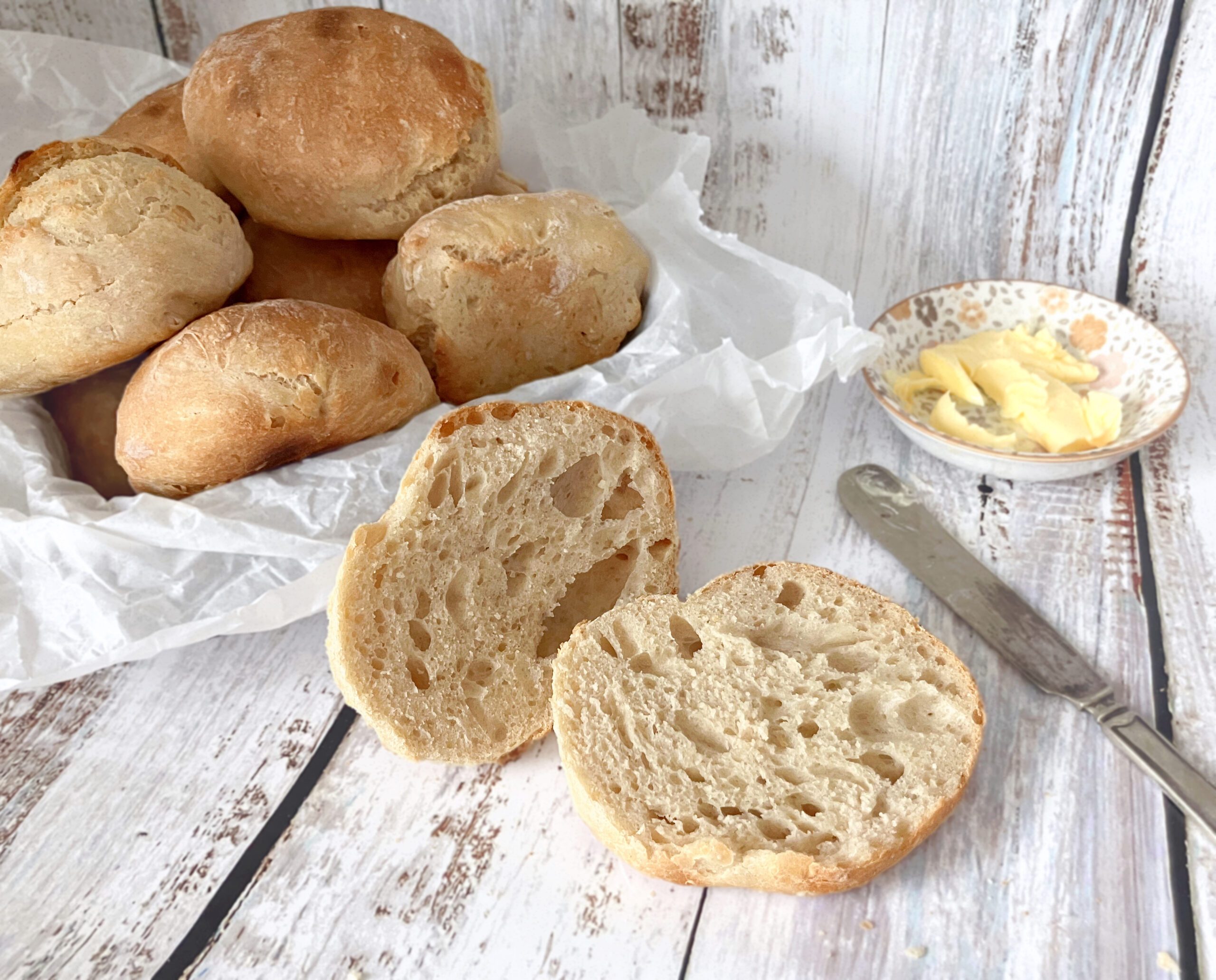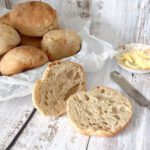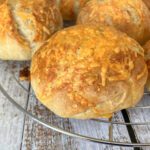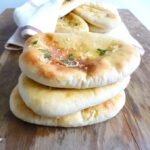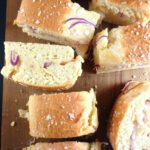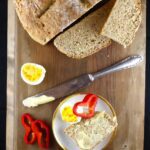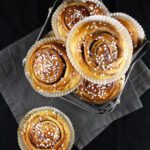No-Knead Swedish Spelt Frallor (Bread Buns)
No-knead Swedish spelt frallor (easy overnight bread buns) are the perfect way to wake up to the smell of freshly baked bread. These soft, fluffy Swedish rolls have a crisp crust and require almost no effort. This no-knead overnight recipe is ideal for beginners or anyone craving fresh, homemade bread in the morning without the work of kneading.
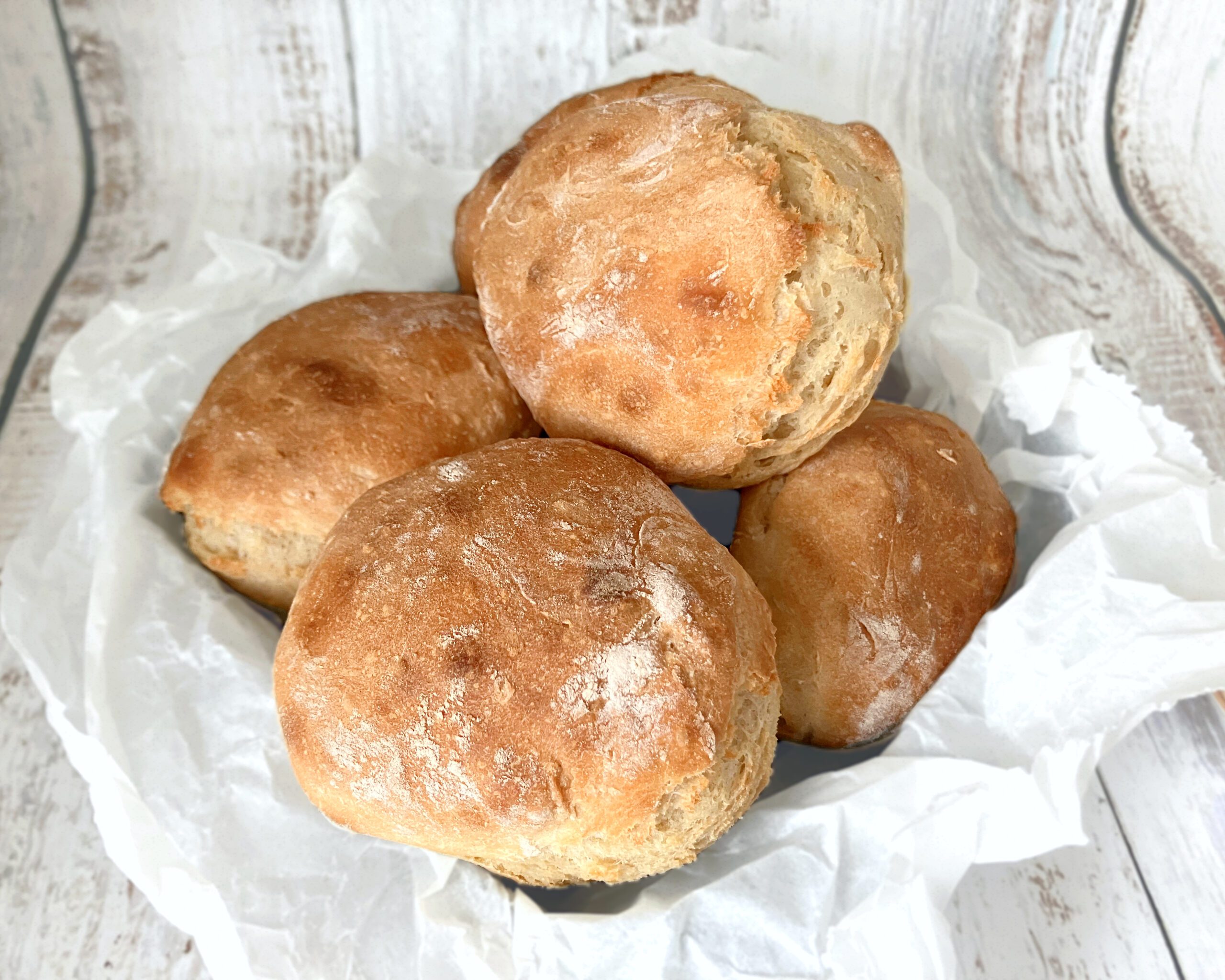
 |
| What are frallor? |
| Frallor are the perfect beginner’s bread |
| Are frallor always plain? |
| How to enjoy frallor |
| More simple Swedish recipes |
Making frallor is quite different from the enriched dough I usually work with. In my usual baking, I rely on eggs and butter to create a rich, soft dough. This dough is then shaped and baked. I’ve used it countless times to create everything from a simple white sandwich loaf to coffee cinnamon buns.
However, with frallor, the process is much simpler. It relies on just basic ingredients like flour, water, yeast, and salt. There’s no need for the richness that eggs and butter provide. Instead, the dough is allowed to rise overnight in the fridge. This allows it time to develop flavour without the need for much handling or additional fat.
The result is a light, airy texture with a crispy crust. Sometimes, great things don’t require extra effort. Frallor are a perfect example of how simplicity can deliver delicious results. It’s an interesting shift from my usual baking routine and a reminder of how versatile bread-making can be. And, being totally transparent here, I have to say that this is my new favourite recipe.
What are frallor?
Frallor are small, soft, round or oval bread rolls that are a staple in Swedish homes. They’re made from simple ingredients like flour, water, yeast, and salt. These rolls are loved for their light texture, crisp crust, and versatility. Frallor have a mild, slightly neutral flavour, making them perfect for both sweet and savoury toppings. Their interior features open, airy holes, similar to those found in a good sourdough. This gives each bite a satisfyingly soft and light texture.
The history of frallor is rooted in Swedish baking traditions. While the exact origin of the roll is unclear, it’s believed that frallor evolved as a smaller, individual-sized version of larger loaves of bread. The word “fralla” has its origins in old Germanic languages, where it referred to a small loaf or roll. Over time, frallor became more common in Swedish households, especially as home baking flourished in the 19th century.
Frallor are the perfect beginner’s bread
Frallor are the perfect beginner’s bread. This easy overnight recipe is a great starting point for anyone new to baking. The dough comes together quickly. With just a simple overnight rise in the fridge, you’ll wake up to soft, fluffy rolls with minimal effort.
There’s no need for complicated techniques or hours of kneading. Just mix, chill, and bake. In fact, avoiding excessive kneading isn’t just a perk; it’s a necessity. Handling the dough too much can affect the texture and prevent those airy holes, similar to those in sourdough, from forming. This hands-off method gives you plenty of time to enjoy the process without feeling rushed. The result? Fresh, homemade bread buns with a light texture and a crispy crust. This recipe is perfect for first-time bakers or anyone looking for an stress-free way to enjoy warm rolls.
Once the dough has risen overnight in the fridge, shaping the frallor is quick and easy. The dough will be soft and very sticky, but don’t worry, this is normal. Simply flour your work surface and hands, then gently divide the dough into equal portions. You can shape each piece into a round or oval roll, depending on your preference. The beauty of this recipe is that the shaping process doesn’t need precision at all. Just form loose, rustic rolls into any shape you like. They’ll bake up beautifully.
Are frallor always plain?
Frallor is an umbrella term in Sweden that refers to various types of small, individual bread rolls, which can vary in shape, texture, and added ingredients but share a soft interior and a slightly crisp crust.
In Sweden, plain frallor are often adapted with ingredients to suit the occasion or personal taste. Many Swedes enjoy adding seeds like sunflower, sesame, or pumpkin to the top of the rolls before baking, giving them a lovely crunch and extra flavour. It’s also common to mix herbs such as rosemary or dill directly into the dough, creating a fragrant, savoury roll.
Some bakers add cheese into the dough or sprinkle it on top for a gooey, melted treat, making the frallor even more irresistible. For a special twist, dried fruits like raisins or cranberries are sometimes added, especially during the colder months or for a festive touch. This adaptability makes frallor a perfect bread to enjoy throughout the year, whether as a simple breakfast roll or part of a more elaborate fika spread.
How to enjoy Swedish spelt frallor
In Sweden, frallor are a beloved part of daily life and are enjoyed in a variety of ways, depending on the time of day. For breakfast, it’s common to split a fralla and spread it with butter, often followed by cheese, ham, or cold cuts. They’re also a popular choice during fika, the Swedish coffee break, where frallor are served with sweet toppings like jam, honey, or chocolate spread.
Many Swedes also like to serve frallor alongside soups or salads, making them a versatile option for lunch or dinner. Whether fresh out of the oven or toasted for extra crunch, frallor are an essential part of Swedish meals, offering comfort and simplicity at any time of day.
Kärleksmums (Swedish chocolate tray bake cake)
Lime and blackberry Swedish mudcake
Caramel apple and blueberry smulpaj (Swedish crumble)
Swedish rye and wholegrain loaf
Chokladbollar (chocolate oat truffles)
Cinnamon bun sockerkaka (sugar cake)
No-Knead Swedish Frallor (Bread Buns)
Ingredients
- 660g (5½ cups) spelt flour (see note 1)
- 7g (2¼ tsp) dried yeast (see note 2)
- 2 tsp salt
- 500ml (2 cups) warm water
- 1 tbsp olive oil
Instructions
- In a large bowl, or stand mixer bowl, add the flour, yeast and salt, and mix to combine.
- Combine the oil and water together, then pour into the dry ingredients.
- Thoroughly mix the ingredients together, but there's no need to overmix.
- Cover the bowl with clingfilm and place in the fridge overnight (see note 3).
- When ready to bake, pre-heat the oven to 250℃ (482℉).
- Pour the dough out onto a well-floured surface. Cover the dough with more flour.
- Pat into a loose rectangle shape (see note 4). Using a pizza cutter, dough cutter or sharp knife, divide the dough into equal pieces.
- Add a little flour to your hands and gently fold the edges underneath to shape them roughly (see note 5).
- The dough is very sticky and hard to move. Either add a little more flour to your hands or use a dough scraper to pick them up (see note 5).
- Place them on a lined baking tray, leaving space between each. Let the buns rest for a little bit, just until the oven is hot enough.
- Bake for around 12 minutes, depending on size (see note 6), but as it is a very hot oven, keep a really close eye on them. Your buns should be very brown but not burned.
- Allow to cool for at least ten minutes before eating. Any leftover can be frozen. Enjoy!
Notes
- You can use all-purpose or even bread flour. Just use the same measurements as specified.
- In Sweden we have something called dried yeast. It is used both in warm liquid to proof and also added directly to flour. I am aware that the US has two options for dried yeast, and I believe instant yeast is the most similar for the purpose of making this particular bread.
- While overnight is ideal, you can leave the dough in the fridge for at least eight hours.
- You need to handle the dough carefully as not to disturb the air bubbles that give the buns their light, fluffy middles. You do not knead it!
- You don't need to do any shaping at all, and although you will need a little additional flour on your hands, try not to add any more to the dough. It's very sticky and meant to be!
- This recipe yields approximately 14 small buns.

